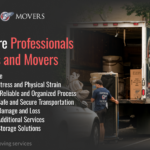A new promotion or job opening may compel you to relocate to a different city. While this move can open new possibilities for your career, relocation can be expensive. In previous years, some taxpayers benefitted from the moving expense deduction, which helped offset some of the costs of relocating. If a move is on the horizon for you in 2018, you might be wondering if this deduction is still available under the new tax bill.
Moving Expense Tax Deduction for 2018 and Beyond
The recently passed tax bill, The Tax Cuts and Jobs Act, eliminates the moving expense deduction for most Americans (active duty military members may still be able to take a deduction). However, if you incurred moving costs in 2017, you can claim the deduction when you file your 2017 return due in April of 2018.
Moving Expense Tax Deduction 2017
Here’s what you need to know about taking the moving expense deduction for 2017.
What Types of Moving Expenses Are Tax Deductible?
IRS Publication 521 enumerates the moving expenses eligible for the deduction. These costs include:
- Mileage for driving your vehicle to your new home (calculated at 17 cents per mile)
- Cost of lodging en route to your new home. Note that meals on the road trip are not deductible.
- Cost of alternative transportation to your new home (i.e., plane or train tickets)
- Cost of moving your belongings – hiring movers or renting a truck or portable storage container.
- The expense of temporary storage during the move.
- Cost of packing and crating your belongings.
- Cost of connecting or disconnecting utilities (i.e., water, gas, electricity).
- Expenses related to transporting household pets.
How to Qualify for the Moving Expense Deduction
Three tests determine whether you may claim this deduction for 2017. To qualify, you must meet the criteria of all three tests.
1. The closely related to starting work test
- Closely related in time: This means that you must start work within a year of the date you arrive at your new location.
- Closely related in place: This means that your commute from your new residence to your new job must be closer than the commute from your old house to the new job site.
2. The distance test
This rule stipulates that the commute from your old residence to the new job location must 50 more miles than the commute from your former home to your old job location. For example, if your old office was five miles from your old house, the new office must be more than 55 miles from your former residence. Members of the military may claim this deduction even if they do not meet this criterion.
3. The other time test
This test states that you must work full-time for at least 39 weeks during the 12 months following your move. For self-employed persons, the time test stipulates that they work at least 39 weeks during the first 12 months following the move and 78 months in the 24 months after the move. Members of the military, retirees that are relocating back to the U.S., surviving spouses of people who worked abroad, people who have been moved to another location, and people who have lost their job for any reason other than misconduct may still qualify for the deduction even if they don’t meet the time test.
IRS Tax Form 3903
To claim the moving expense deduction, fill out IRS tax form 3903 and attach to your 2017 tax return. Enter the result on line 26 of Form 1040.






